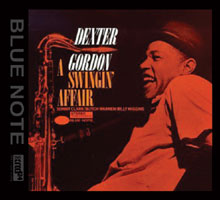Tina Brooks • Back to the Tracks
Dexter Gordon • A Swingin' Affair
exter Gordon and Tina Brooks had quite a few things in common, among them the fact that when these two sessions were recorded, both men were trying to remake their careers. Gordon was finishing off a quartet of albums for Blue Note over a two-year stretch that would resurrect a career that had fallen on hard times after a decade lost to drug abuse. Brooks, despite his magnificent writing and playing for Blue Note as both leader and sideman, released just one album that quickly faded into obscurity. Back to the Tracks was not released until the mid-1980s, more than twenty years after it was recorded and Brooks' death. Both Gordon and Brooks deserved wider recognition, but only one of them received it. A Swingin’ Affair, featuring Gordon up front and a rhythm section of pianist Sonny Clark, bassist Butch Warren, and drummer Billy Higgins, shows a man totally in control of his instrument and art. Gordon wrote two of the numbers recorded here, the classics-in-waiting "Soy Califa" and "McSplivens," both of which grab attention with their up-tempo beats. His tone is huge, almost as big as the man himself, who stood (towered may be a better word) six feet six inches tall. But he could swing, as demonstrated by his two contributions to this album, as well as play ballads, "Don't Explain" and "You Stepped Out of a Dream" offering ample evidence. Back to the Tracks was one of the finest jazz albums never released in its day. It had an all-star supporting cast -- trumpeter Blue Mitchell, alto saxophonist Jackie McLean (on one track), pianist Kenny Drew, bassist Paul Chambers, and drummer Art Taylor -- and three Brooks originals. Right from the start, the title cut swings as hard as anything from Blue Note and is dominated by Brooks' unique tenor sound -- I’ve heard it described as keening, and it fits. That this album, despite being numbered, cataloged, scheduled for release, and even printed on inner sleeves of other Blue Note releases, never saw the light of day until 1985 is one of Alfred Lion’s bigger mistakes. We’ll never know what might have happened to Tina Brooks’ career had this album appeared. It may have given Brooks the opportunity to keep this band together, get regular work, and perhaps turn his life around, becoming one of Blue Note’s stars in the process. The sound of these two albums is fairly similar, with a slight edge going to Back to the Tracks, perhaps because the tapes were in better condition, due to the album not being released. The front line of Brooks’ tenor and Mitchell’s trumpet sounds brash and realistic. The rhythm section has better-than-average focus, with Taylor’s drums having the requisite snap, crackle and pop, and Chambers’ bass sounding deep and woody. Drew’s piano is easily heard, even if, as was Rudy Van Gelder’s wont, it sounds rather small and boxy. But you do hear every note. A Swingin' Affair was a much more popular album and has been reissued many, many times, yet the tapes still hold up well. Gordon’s tenor is big, bold and fully realistic, with a tone that is completely different from Brooks'. The rhythm section receives the same treatment, with the exception of the bass, which is more clearly defined. I’ve heard both albums in various forms, and these
XRCDs compare with the very best of them. If you’re looking for the definitive
digital versions, your search can begin and end here. |


